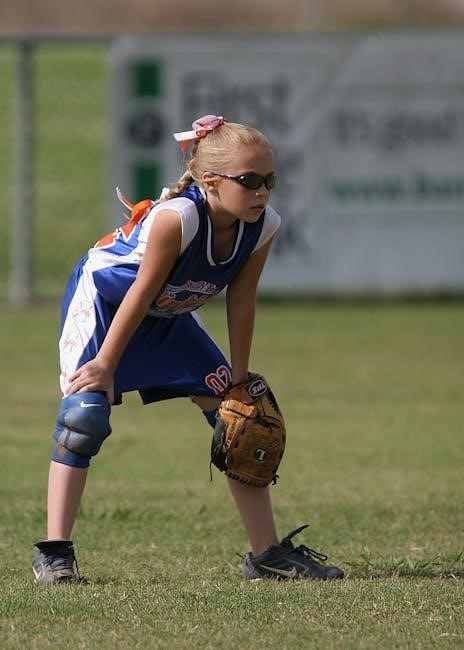Softball glove sizing ranges from 8 to 15 inches, with proper fit crucial for performance and comfort․ Factors like age, position, and hand size determine the ideal glove size․
Importance of Proper Glove Fit
A proper-fitting softball glove is essential for optimal performance, comfort, and control․ A glove that is too tight may restrict movement, while one that is too loose can hinder grip and precision․ Proper fit ensures better ball control, quicker transitions, and improved accuracy during plays․ It also reduces the risk of injury by providing adequate support and protection for the hand․ Additionally, a well-fitting glove enhances confidence, allowing players to focus on their game without distractions․ For younger players, a correctly sized glove helps develop proper fielding techniques and prevents bad habits․ Ultimately, the right fit maximizes efficiency and contributes to overall success on the field․
Basic Considerations for Choosing a Glove Size
When selecting a softball glove, consider your age, position, and hand size․ Youth players typically require smaller gloves, while older players and those in specific positions may need larger sizes․ For example, infielders often prefer smaller gloves for quicker ball transfer, while outfielders opt for larger ones to handle fly balls․ Pitchers may choose a closed-web glove for concealment, whereas catchers need sturdier, larger mitts․ Measuring from the tip of your index finger to your wrist provides a baseline size․ Material and web type also influence fit and functionality․ Ensuring the glove is snug yet comfortable allows for optimal performance and control during plays․

How to Measure for a Softball Glove
To measure for a softball glove, flex your hand and measure from the tip of your index finger to the start of your wrist in inches․
Step-by-Step Measurement Guide
- Flex your hand slightly to ensure an accurate measurement․
- Measure from the tip of your index finger to the base of your wrist․
- Record the measurement in inches to determine your glove size․
- Ensure the glove fits snugly but allows for proper movement․
- Consider your age and position to refine the size further․
This method ensures a precise fit, enhancing performance and comfort during play․
Factors to Consider When Measuring
When measuring for a softball glove, several factors must be considered to ensure the best fit․ Age is a key factor, as younger players typically require smaller gloves, while older players may need larger sizes․ Position is another important consideration, as infielders, outfielders, and pitchers often prefer different glove sizes․ Hand size and finger length also play a role, as they affect how the glove will fit; Additionally, the web type and material of the glove can influence sizing preferences․ Proper fit ensures comfort and performance, so it’s essential to measure accurately and consider these elements when selecting a glove․
Ensuring a Proper Fit
A proper fit is essential for optimal performance and comfort․ The glove should feel snug but not tight, allowing for flexibility and control․ Ensure the fingers fit comfortably without excess room, and the wrist closure provides secure support․ Proper fit ensures quick responses during plays, especially for infielders needing rapid ball transfers․ Outfielders and pitchers may prefer a slightly looser fit for better grip and control․ Trying the glove on with the same gear worn during games, like batting gloves, helps achieve an accurate fit․ Proper fit also prevents blisters and discomfort, ensuring the glove becomes an extension of the player’s hand․ Always test the glove during drills to confirm it meets positional needs․
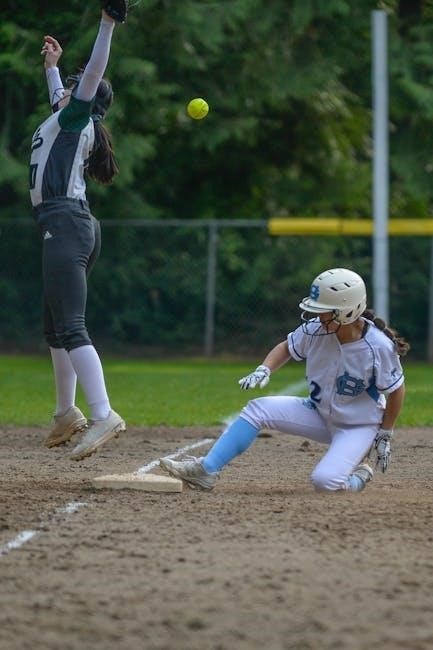
Softball Glove Sizing by Position
Softball glove sizes vary by position, with pitchers preferring smaller gloves (11-12․5″) for control, while outfielders opt for larger sizes (12-13″) to handle fly balls effectively․
Pitcher’s Glove Size Recommendations
Pitchers typically prefer smaller gloves, ranging from 11 to 12․5 inches, to ensure better control and quicker ball transfer․ A closed web design is ideal for pitchers, as it helps conceal the ball during pitches․ The snug fit allows for precise grip and quick releases, which are essential for effective pitching․ Proper sizing ensures the glove isn’t too tight, enabling comfortable movement and flexibility․ Breaking in the glove is crucial for pitchers to maintain consistency and performance․ The smaller size also allows for easier handling, making it easier to grip and throw the ball accurately․ This size range is recommended for both youth and adult pitchers to optimize their skills on the mound․
Catcher’s Glove Size Guide
Catchers require larger gloves to handle high-speed pitches and provide a secure pocket․ Sizes typically range from 11․5 to 12․5 inches, offering extra padding and durability․ The mitt-style design with a closed web is ideal for catchers, as it absorbs impact and protects the hand․ Proper sizing ensures the glove fits snugly, allowing for quick transitions from catching to throwing․ The larger size accommodates the need for a deep pocket, crucial for controlling pitches․ Break-in time is essential for catchers to ensure the glove molds to their hand, providing both comfort and performance during games․ This size range is recommended for both youth and adult catchers to handle the demands of the position effectively․
First Base Glove Size Suggestions
First basemen typically use larger gloves to handle throws from other infielders effectively․ Gloves for first base usually range in size from 12 to 12․5 inches․ The mitt-style design with a sloped pocket allows for easy scooping of low throws, while the larger size provides a bigger target for infielders․ A closed or single-piston web is commonly preferred, offering support and durability․ The size recommendation ensures the glove is large enough for fielding but not overly cumbersome for quick transitions to throws․ This size range is ideal for both youth and adult first basemen, balancing functionality and comfort․ Proper sizing is crucial for performance at this key defensive position․
Infield Glove Size Options
Infield gloves are designed for quick transfers, typically ranging from 11․5 to 12․5 inches․ This smaller size allows infielders to field and throw the ball rapidly․ The open pocket design facilitates easy ball retrieval, while the shorter length ensures a snug fit and control․ For younger players, sizes between 10․5 and 11․25 inches are recommended, ensuring the glove isn’t too bulky․ Adults usually prefer 11․5 to 12․5 inches, balancing agility and catching effectiveness․ The size should allow a comfortable fit, enabling quick actions and precise throws․ Proper sizing enhances infield performance, making it essential to choose a glove that matches the player’s hand and position needs․ This range ensures optimal functionality for infielders across all age groups and skill levels․
Outfield Glove Size Recommendations
Outfield gloves are typically larger than infield gloves, ranging from 12 to 13 inches․ The larger size provides a deeper pocket, aiding in catching fly balls and ensuring secure grip․ This extra length helps outfielders handle longer throws and track high pop flies effectively․ The recommended size allows for better control and reach, essential for outfield positions․ Players should ensure the glove fits comfortably, as a too-large glove can hinder performance․ The size should accommodate the player’s hand size while maintaining functionality․ Proper sizing ensures optimal performance, making it crucial to select a glove that balances reach and control․ This range is standard for most outfielders, providing the necessary support and agility for the position․
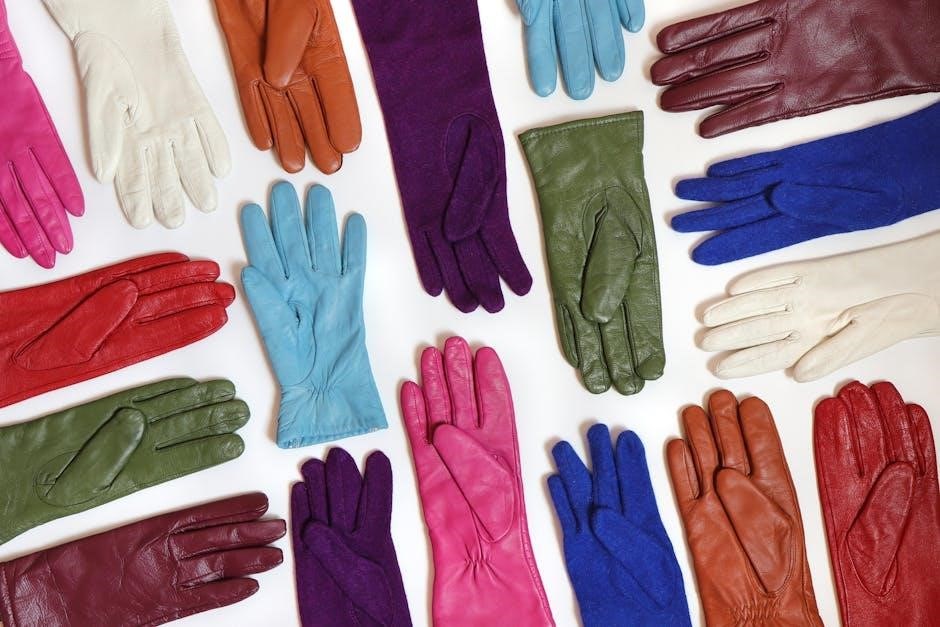
Glove Size by Age Group
Softball glove sizes vary by age: players under 8 use 9-10 inches, those aged 10-14 use 10-12 inches, and players over 15 use 11-13 inches․
Softball Glove Sizes for Players Under 8
For players under 8 years old, softball gloves typically range between 9 to 10 inches․ This size is ideal for young players, as it helps them develop proper catching and throwing habits․ A smaller glove allows better control and maneuverability, which is essential for skill development․ The 9-10 inch range is recommended for all positions, except for catchers, who may require a slightly larger glove․ Measuring from the tip of the index finger to the wrist ensures a snug fit, preventing the glove from being too bulky․ Proper sizing is crucial at this age to avoid hindering growth and coordination․ This size range provides the perfect balance between comfort and functionality for young athletes․

Recommended Sizes for Players Aged 10-14
For players aged 10-14, softball gloves typically range between 10 to 12 inches․ This size range provides a balance between control and ease of use, allowing young players to develop their skills effectively․ Measuring from the tip of the index finger to the start of the wrist ensures the correct fit․ A 10-12 inch glove offers enough pocket size for catching without being overly bulky, making it ideal for this age group․ It’s important to choose a size that allows for growth while maintaining comfort and functionality․ Proper sizing at this stage helps improve dexterity and confidence in handling the ball․ Factors like position and personal comfort should also be considered when selecting the perfect glove size․
Glove Sizes for Players Over 15
Players over 15 typically use gloves sized between 11 to 13 inches, ensuring a snug yet comfortable fit․ This range offers a larger pocket for better control, suitable for advanced play․ Measuring from the tip of the index finger to the wrist provides an accurate fit․ The 11-13 inch range supports the strength and dexterity of older players, allowing for precise handling․ It’s crucial to balance size with ease of movement, as a glove that’s too large may hinder performance․ Proper sizing at this level enhances both catching efficiency and throwing accuracy, making it essential for competitive play․ Choosing the right size ensures optimal performance and comfort for experienced players․

Web Type and Its Impact on Glove Size
The web type affects glove size and fit, influencing proper performance, with different designs (open, closed) suiting various positions and player preferences effectively․
Understanding Different Web Designs
Softball gloves feature various web designs, each serving specific purposes․ The web is the part connecting the thumb and index finger․ Designs include closed, open, H-web, I-web, and X-web․ A closed web provides more support and conceals the ball, ideal for pitchers․ An open web allows quicker ball access, favored by infielders․ The H-web combines durability and flexibility, while the I-web offers a tighter pocket․ The X-web is sturdy and commonly used by outfielders․ Each design impacts glove size perception and functionality, making it crucial to choose based on position and play style․
Choosing the Right Web Type for Your Position
The web type of a softball glove is tailored to specific positions․ Pitchers often prefer a closed web for ball concealment and control․ Infielders benefit from an open web or I-web, allowing quicker transfers․ Outfielders may opt for a H-web or X-web for durability and a larger pocket․ First basemen typically use closed or open webs, depending on their preference․ Catchers usually have a closed web for added support․ Each web design enhances performance for its intended role, ensuring the glove complements the player’s needs․ Choosing the right web type is essential for optimal gameplay and ball handling․ Proper selection can improve fielding, throwing, and overall team performance․ Always match your position with the appropriate web design for peak efficiency and effectiveness on the field․
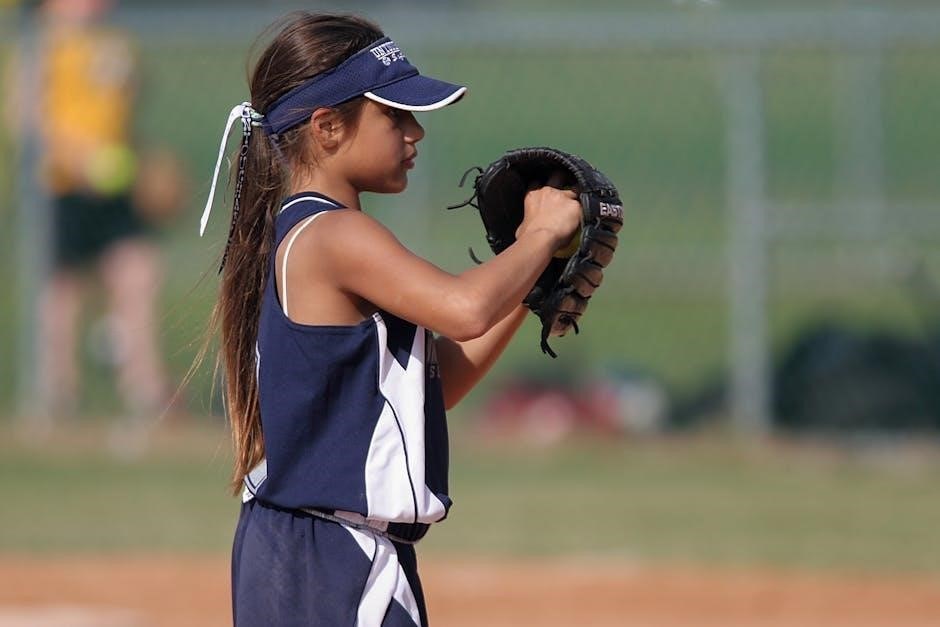
Material and Glove Size
Glove material impacts size and fit, with leather offering durability and synthetic options providing a lighter feel․ Choose materials that suit your hand size and position needs․
How Glove Material Affects Size and Fit
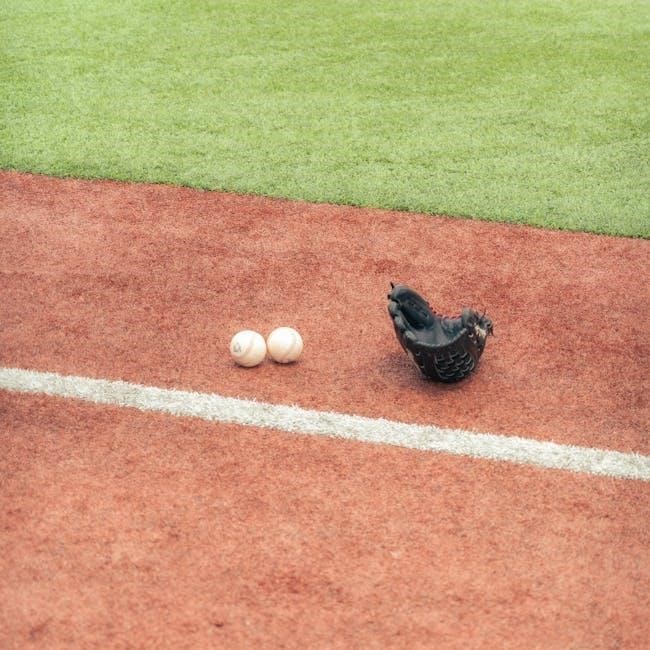
Different materials influence both the size and how a glove fits․ Leather gloves are durable but may require breaking in, while synthetic materials are lighter and more flexible․ The thickness of the leather can affect the overall size, with thinner leathers offering a snugger fit․ Synthetic gloves often have a softer feel, making them easier to break in and potentially more suitable for smaller hands․ However, they may not last as long as leather gloves․ The material choice should align with your position and personal preference to ensure optimal performance and comfort on the field․
Popular Materials for Softball Gloves
Softball gloves are primarily made from leather, synthetic materials, or a combination of both․ Leather gloves are the most traditional and preferred by elite players due to their durability and feel․ They require breaking in but offer a snug, responsive fit over time․ Synthetic gloves are lighter, easier to break in, and more affordable, making them ideal for younger players or those seeking a softer feel․ Hybrid gloves blend leather and synthetic materials, offering a balance of durability and flexibility․ The choice of material depends on personal preference, playing style, and position, ensuring optimal performance and comfort during games․
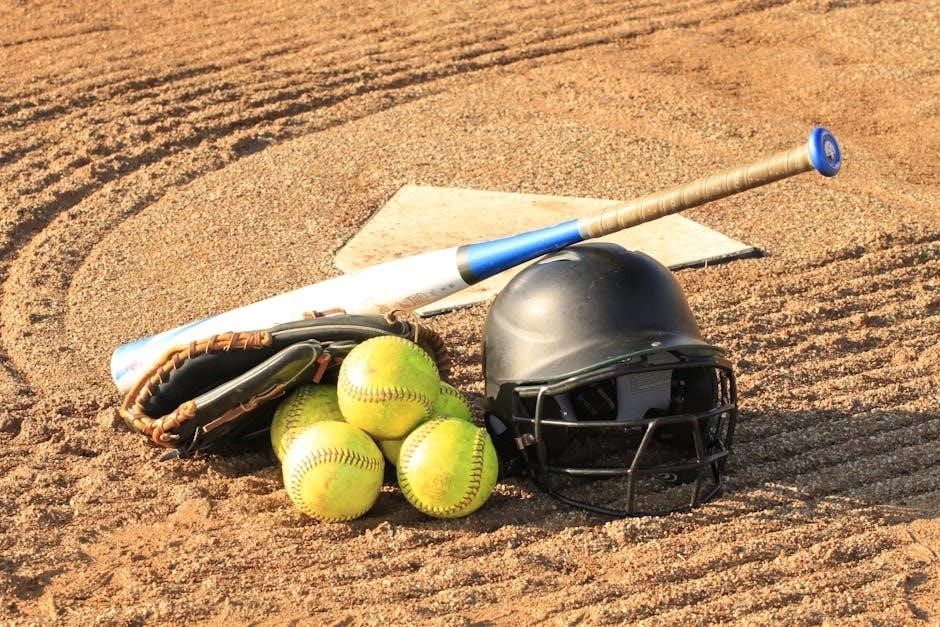
Breaking in Your New Glove
Breaking in a softball glove ensures comfort and performance․ Apply conditioner, work the leather, and shape the pocket for a snug, responsive fit tailored to your hand․
Tips for Breaking in a New Softball Glove
Breaking in a new softball glove requires patience and proper techniques․ Start by applying a leather conditioner to soften the material․ Use a mallet or your hands to gently pound the pocket and creases, shaping it to your preference․ Place a softball in the pocket and tie the glove shut with a rubber band overnight to deepen the pocket․ Wear the glove during practice to mold it to your hand․ Avoid using heat, as it can damage the leather․ Regularly flex the glove to maintain its suppleness․ Proper break-in ensures a comfortable fit, improved performance, and longevity of the glove․
Importance of Proper Break-In
A well-broken-in softball glove enhances performance and comfort․ Proper break-in ensures the glove conforms to your hand, providing a snug fit and better control․ It minimizes the risk of blisters and discomfort during play․ A broken-in glove also improves the pocket’s ability to secure the ball, reducing errors․ Additionally, proper break-in extends the glove’s lifespan by preventing premature wear․ A glove that isn’t broken in can feel stiff, affecting your ability to field and throw effectively․ Investing time in the break-in process ensures optimal functionality and longevity, making it a crucial step for any player looking to elevate their game․
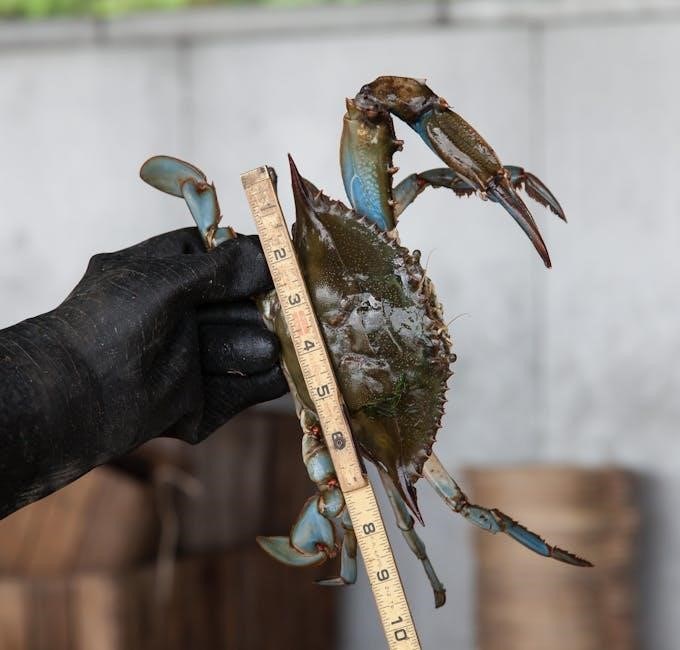
Glove Care and Maintenance
Regular conditioning with leather oil and avoiding harsh chemicals help maintain the glove’s integrity․ Store it in a cool, dry place to prevent cracking and extend durability․
How to Keep Your Glove in Great Condition
To maintain your softball glove, start by regularly conditioning it with a high-quality leather conditioner or oil․ Avoid harsh chemicals or excessive water, as they can dry out the leather․ Gently wipe away dirt and grime with a clean, damp cloth, paying attention to the webbing and laces․ Store the glove in a cool, dry place, away from direct sunlight, to prevent cracking and fading․ Consider using a glove bag or wrapping it in a towel to protect it when not in use․ For optimal shape retention, place a ball in the pocket and secure it with a glove tie during the off-season․ Regularly inspect and condition the laces to prevent fraying․ Avoid over-conditioning, as this can make the leather too soft․ By following these steps, you’ll extend the life of your glove and keep it performing at its best․
Extending the Life of Your Softball Glove
To extend the life of your softball glove, proper care is essential․ Regularly condition the leather with a high-quality conditioner to maintain its flexibility and prevent cracking․ Avoid exposing the glove to direct sunlight or extreme temperatures, as this can cause the leather to dry out․ Store the glove in a cool, dry place when not in use, using a glove bag or wrapping it in a towel for added protection․ Avoid using harsh chemicals or abrasive cleaners, as they can damage the material․ For long-term storage, place a ball in the pocket and secure it with a glove tie to maintain its shape․ By following these care tips, you can ensure your glove remains durable and performs optimally for years․
